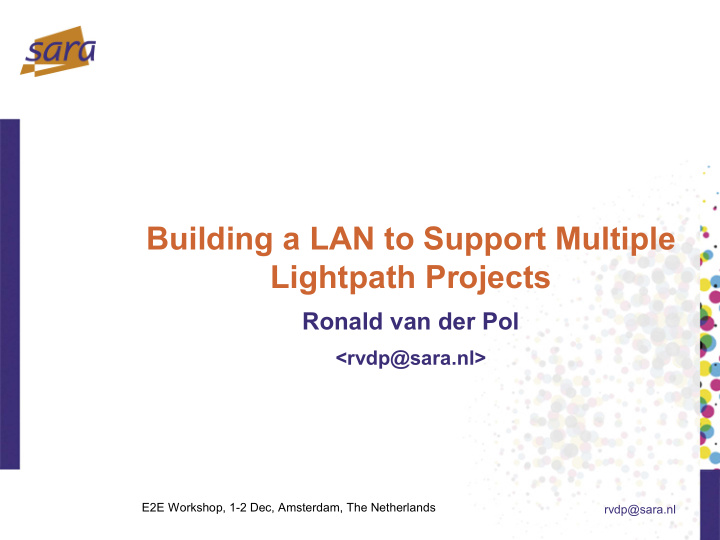



Building a LAN to Support Multiple Lightpath Projects Ronald van der Pol <rvdp@sara.nl> E2E Workshop, 1-2 Dec, Amsterdam, The Netherlands rvdp@sara.nl
About SARA Computing and Networking services Houses and operates national supercomputer Huygens Houses and operates national cluster Lisa LightHouse (joint lab of SARA, UvA and SURFnet for optical networking experiments and demos) SURFnet's subcontractor for SURFnet6 NOC SURFnet's subcontractor for NetherLight NOC One of the co-location sites of the AMS-IX CERN LHC Tier-1 site LOFAR Tier-1 site E2E Workshop, 1-2 Dec, Amsterdam, The Netherlands rvdp@sara.nl
LHC OPN Tier-1 Site E2E Workshop, 1-2 Dec, Amsterdam, The Netherlands rvdp@sara.nl
LOFAR Tier-1 Site LOw Frequency ARray Radiotelescope Consists of Sensor Fields Data Storage @ SARA E2E Workshop, 1-2 Dec, Amsterdam, The Netherlands rvdp@sara.nl
IMAU Climate Model Rendering at SARA Visualization at IMAU Connected with a SURFnet6 1G lightpath E2E Workshop, 1-2 Dec, Amsterdam, The Netherlands rvdp@sara.nl
Traditional ISP Connection router router SURFnet SARA router router Layer 3 IP interconnect E2E Workshop, 1-2 Dec, Amsterdam, The Netherlands rvdp@sara.nl
Introduction of Lightpaths ? router router SARA SURFnet6 ? Hybrid Network router router ? E2E Workshop, 1-2 Dec, Amsterdam, The Netherlands rvdp@sara.nl
Lightpath Challenges Interconnect sites at L2 or at L3? How to handle security? How to handle addressing? How to protect against configuration errors and accidents at other site? E2E Workshop, 1-2 Dec, Amsterdam, The Netherlands rvdp@sara.nl
L2 versus L3 L2 pros Cheap Ethernet switches L2 cons No IP ACLs Mixing of administrative domains One broadcast domain, one IP subnet L3 pros Well-known (we know how to do this between sites) Supports ACLs and firewall Easier fault resolution Ping, traceroute, router reachability L3 cons Routers (and L3 switches) usually more expensive E2E Workshop, 1-2 Dec, Amsterdam, The Netherlands rvdp@sara.nl
SARA's Requirements Keep services separated Access to one service does not mean access to another service, unless explicitly allowed No (accidental) connectivity between lightpaths via SARA No (accidental) Internet connectivity via SARA Solution must scale to multiple services and multiple lightpath peer sites Solution must support multiple 10G connections No big routing tables on the servers Only a default gateway Segmenting the routing tables e.g. No LHCOPN prefixes in global routing table E2E Workshop, 1-2 Dec, Amsterdam, The Netherlands rvdp@sara.nl
Problems Encountered in LHCOPN Only storage servers traffic allowed on the LHCOPN Other hosts and servers must reach CERN via Internet Traditional destination based routing does not work We needed to find a good, scalable solution CERN LHCOPN Internet SARA router SARA Data storage E2E Workshop, 1-2 Dec, Amsterdam, The Netherlands rvdp@sara.nl
SARA's Choices Interconnect at L3 L2 only for few very simple cases BGP routing BGP detects when peer is unreachable BGP needed when there are multiple paths Routing segmentation Put each lightpath project in its own virtual router Good way to keep projects and services separated E2E Workshop, 1-2 Dec, Amsterdam, The Netherlands rvdp@sara.nl
Virtual Routing Internet LHCOPN if1 if8 IMAU if2 LHCOPN if7 if3 if6 LHCOPN LOFAR if4 if5 Storage cluster Render cluster Global Table: if1, if4, if5 VR1 (LHCOPN): if6, if7, if8 VR2 (IMAU): if2 VR3 (LOFAR): if3 E2E Workshop, 1-2 Dec, Amsterdam, The Netherlands rvdp@sara.nl
Virtual Router Solution Virtual routing is a scalable way to keep services and lightpath peers separated Problem with traditional destination based routing + ACLs: ACLs are difficult to maintain Not a scalable solution Configuration errors mean unwanted access Problem with policy based routing: Only 1 next hop, does not work with multiple links Next hop is specified as specific interface Does not use BGP, no route information exchange No link failure detection when switches in path E2E Workshop, 1-2 Dec, Amsterdam, The Netherlands rvdp@sara.nl
Problems Encountered Often little BGP knowledge at peer sites Many peer sites do not have a global AS Most routers have insufficient Virtual Routing capabilities We had to gain knowledge of virtual routing Detecting of link failures often difficult Link failures do not propagate through Ethernet switches (BGP session, 802.1ag, BFD, ...) E2E Workshop, 1-2 Dec, Amsterdam, The Netherlands rvdp@sara.nl
Conclusions Supporting multiple lightpaths and multiple services is not a trivial task Virtual routing is a relatively simple way to handle the routing and separation requirements Routing requirements often result in the choice for BGP E2E Workshop, 1-2 Dec, Amsterdam, The Netherlands rvdp@sara.nl
Thank You Ronald van der Pol rvdp@sara.nl E2E Workshop, 1-2 Dec, Amsterdam, The Netherlands rvdp@sara.nl
Recommend
More recommend